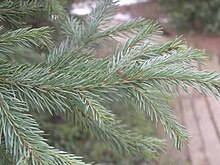Siberian spruce
| Siberian spruce | ||||||||||||
|---|---|---|---|---|---|---|---|---|---|---|---|---|

Forest with Siberian spruce trees in Chelyabinsk Oblast, Russia |
||||||||||||
| Systematics | ||||||||||||
|
||||||||||||
| Scientific name | ||||||||||||
| Picea obovata | ||||||||||||
| Ledeb. |
The Siberian spruce ( Picea obovata ) is a species from the pine family (Pinaceae). It is native to northern Eurasia .
description
The Siberian spruce grows as an evergreen tree that can reach heights of growth of up to 40 meters and diameters of up to 1 meter at chest height . The trunk ends in a pyramidal crown . The dark gray trunk bark peels off in irregularly shaped pieces. The hairy bark of the branches is initially yellow to light yellow-brown and turns gray over time.
The resinous, light yellow-brown winter buds are cone-shaped. The curved needles are 1.3 to 2.3 centimeters long and about 0.2 centimeters wide and have a linear-quadrangular shape and a quadrangular or broad diamond-shaped cross section. Its tip is pointed. There are five to seven stomatal lines on the top of the needle and four to five on the bottom .
The Siberian spruce is single-sexed ( monoecious ) and the flowering time is in May. The cones are oval-cylindrical to cylindrical in shape with a length of 5 to 11 centimeters and a thickness of 2 to 3 centimeters. They are initially purple to dark purple and turn brown until they are ripe in September or October. The seed scales are wedge-shaped to obovate and are 1.8 to 2.1 inches long and 1.5 to 1.8 inches wide. The triangular to obovate, dark brown seeds are about 5 millimeters long. They have an oblong-obovate wing, which is 0.9 to 1.1 centimeters long.
The number of chromosomes is 2n = 24.
Distribution and location
The natural range of the Siberian spruce is in northern Eurasia . It stretches from the European part of Russia eastwards to Kamchatka and the Sea of Okhotsk . To the south it extends to Kazakhstan, Mongolia and the Chinese Xinjiang .
The Siberian spruce thrives, at least in China, at altitudes of 1200 to 2000 meters. It is a tree species of the boreal coniferous forest . The species grows mainly in mountains on mountain slopes, along rivers and in valleys on shallow permafrost soils . Temperatures at the locations can drop below −60 ° C in winter. From Northern Europe to the Urals there is the formation of mixed stands with the Norway spruce ( Picea abies ), with which the Siberian spruce also forms the hybrid Picea × fennica . In wet locations in the eastern distribution area, there is often a mixed population with the Dahurian larch ( Larix gmelinii ). In the southern distribution area mainly pure stands occur, except in the Altai, where the Siberian fir ( Abies sibirica ) occurs as a socialized species. Various types of birch ( Betula ) and poplar ( Populus ) can also be found in deeper locations with well-aerated soils, and in dry locations the forest pine ( Pinus sylvestris ) grows together with the Siberian spruce.
The Siberian spruce is classified as "not endangered" in the IUCN Red List . There are no threats to the existence of the company.
use
The wood of the Siberian spruce is used as construction timber, for the production of carvings, masts and pulp. Are from the bark tannins won.
Systematics
Picea obovata is assigned to the subgenus Picea , the section Picea , the subsection Picea and the series Picea within the genus of the spruce trees ( Picea ) .
It was first described as Picea obovata in 1833 by Carl Friedrich von Ledebour in Flora Altaica , Volume 4, Page 201. Picea obovata Ledeb. has the synonyms Abies obovata (Ledeb.) Loudon , Pinus obovata (Ledeb.) Turcz. , Picea abies subsp. obovata (Ledeb.) Hultén .
Where their distribution area overlaps, the Siberian spruce and the common spruce ( Picea abies ) form the introgressive hybrid Picea × fennica (rule) Kom . A study of the isoenzymes carried out by Konstantin Krutovskii and Fritz Bergmann in 1995 showed that the Siberian and the common spruce differ only very slightly from one another. They therefore suspect that these are two different geographic races of the same species.
swell
- Christopher J. Earle: Picea obovata. In: The Gymnosperm Database. www.conifers.org, November 28, 2012, accessed on August 17, 2013 .
- Liguo Fu, Nan Li, Thomas S. Elias & Robert R. Mill: Pinaceae . Picea. In: Wu Zhengyi, Peter H. Raven & Hong Deyuan (eds.): Flora of China . Cycadaceae through Fagaceae. Volume 4. Science Press and Missouri Botanical Garden Press, Beijing and St. Louis 1999, ISBN 0-915279-70-3 , Picea obovata , pp. 26 (English, Picea obovata - online - this printed work is online with the same text).
Individual evidence
- ↑ a b c d e f Liguo Fu, Nan Li, Thomas S. Elias & Robert R. Mill: Pinaceae . Picea. In: Wu Zhengyi, Peter H. Raven & Hong Deyuan (eds.): Flora of China . Cycadaceae through Fagaceae. Volume 4. Science Press and Missouri Botanical Garden Press, Beijing and St. Louis 1999, ISBN 0-915279-70-3 , Picea obovata , pp. 26 (English, Picea obovata - online - this printed work is online with the same text).
- ↑ a b Picea obovata at Tropicos.org. Missouri Botanical Garden, St. Louis, accessed August 1, 2016.
- ↑ a b c Christopher J. Earle: Picea obovata. In: The Gymnosperm Database. www.conifers.org, November 28, 2012, accessed on August 17, 2013 .
- ↑ a b c Picea obovata in the endangered Red List species the IUCN 2013. Posted by: A. Farjon, 2011. Accessed August 17, 2013.
- ↑ Picea obovata. In: The Plant List. www.theplantlist.org, accessed on August 17, 2013 .
- ↑ Rafaël Govaerts (ed.): Picea. In: World Checklist of Selected Plant Families (WCSP) - The Board of Trustees of the Royal Botanic Gardens, Kew . Retrieved April 15, 2019.


